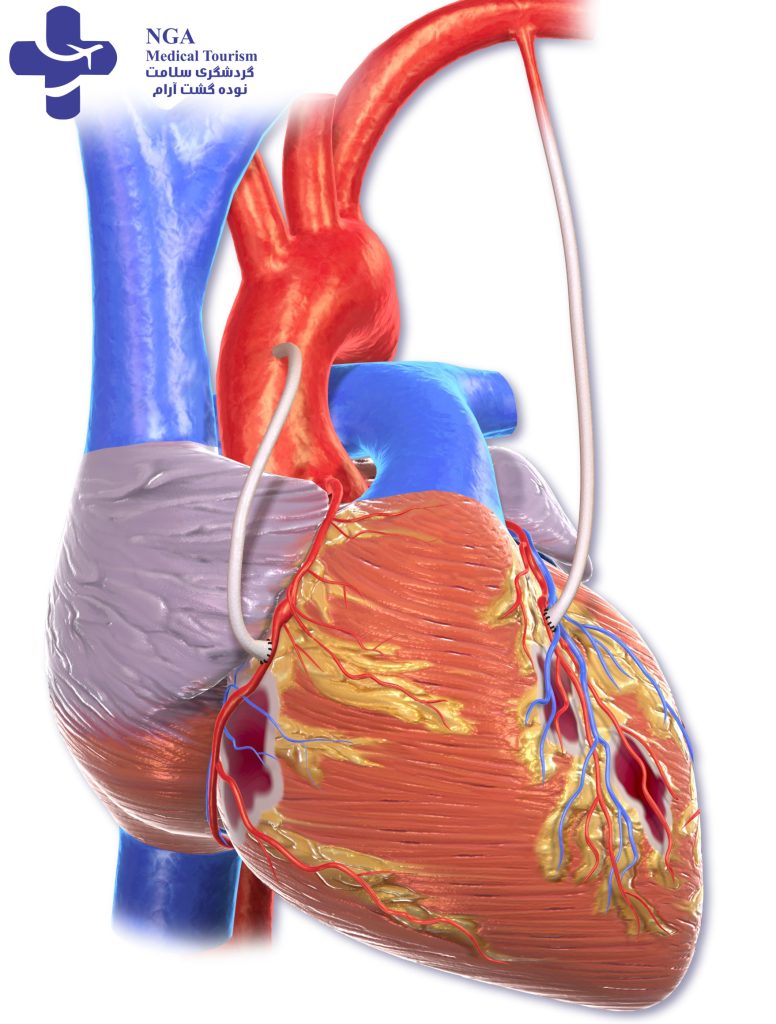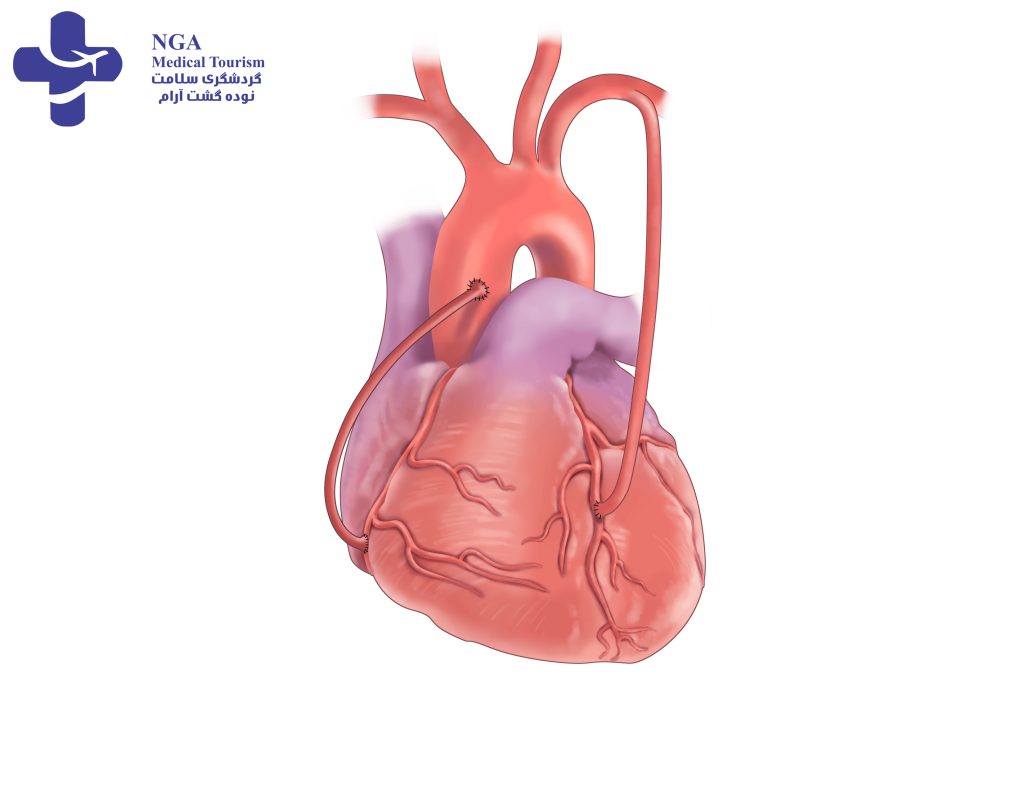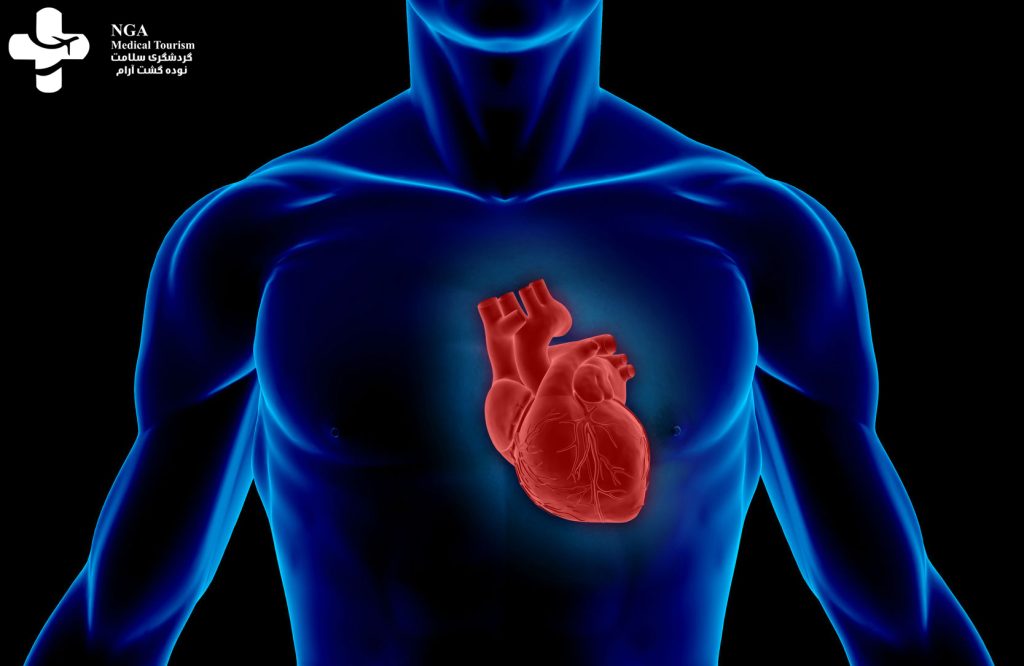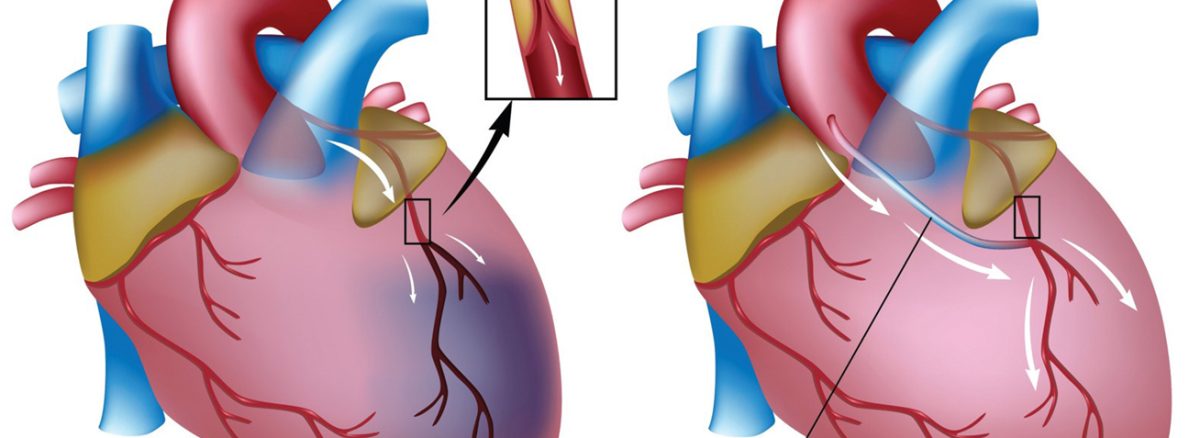Coronary artery bypass graft (CABG) surgery is a type of heart surgery that is used to treat coronary artery disease. In this procedure, a surgeon uses a vein or artery from another part of the patient’s body to create a detour around a blocked or narrowed coronary artery. The detour allows blood to flow more freely to the heart muscle, which can relieve chest pain (angina) and improve heart function.
Overview
coronary artery bypass graft surgery (CABG) is considered open heart surgery. It involves making a large incision in the chest to access the heart and blood vessels. During the procedure, the heart may be temporarily stopped, and a heart-lung bypass machine is used to circulate blood and oxygen throughout the body. CABG is a major surgical procedure performed in a hospital setting.
What is coronary bypass graft surgery?
Coronary artery bypass graft surgery (CABG) is a minimally invasive procedure used to treat coronary artery disease (CAD). CAD occurs when the coronary arteries, which supply oxygen and nutrients to the heart muscle, become narrowed or blocked due to the buildup of fatty material on their walls.
During the CABG procedure, a healthy blood vessel, usually taken from the leg or chest, is used to bypass the blocked portion of the coronary artery. The graft is attached above and below the blockage, allowing blood to bypass the narrowed or blocked area and reach the heart muscle. This surgical technique is known as coronary artery bypass surgery.
Traditionally, CABG involved a large incision in the chest, temporarily stopping the heart, and using a heart-lung bypass machine to pump blood during the procedure. However, advancements have led to less invasive approaches. “Off-pump” procedures, where the heart does not need to be stopped, were developed in the 1990s. Additionally, minimally invasive techniques, such as keyhole surgery and robotic procedures, have been introduced, involving smaller incisions and the use of specialized devices.
These advancements in CABG techniques provide alternatives to the traditional “open heart” procedure, with the goal of reducing the invasiveness of the surgery and improving patient outcomes.
Why might I need coronary artery bypass surgery?
Why it’s done
Coronary artery bypass graft surgery (CABG) is used by doctors to treat blockages or narrowing of the coronary arteries, which supply blood to the heart muscle. This procedure aims to restore the blood supply to the heart.
Symptoms of coronary artery disease (CAD) can include chest pain, fatigue, palpitations, abnormal heart rhythms, shortness of breath, swelling in the hands and feet, and indigestion. However, it’s possible to have early-stage CAD without experiencing any symptoms. The disease may progress until there is sufficient artery blockage to cause symptoms or complications. If the blood supply to the heart muscle continues to decrease due to a growing blockage in a coronary artery, it can lead to a heart attack. If blood flow cannot be restored to the affected area of the heart muscle, the tissue may die.
There can be other reasons for your doctor to recommend CABG surgery, depending on your individual circumstances.

What are the risks of coronary artery bypass surgery?
Risks
Coronary artery bypass graft surgery (CABG) carries certain risks, which may include:
- Bleeding during or after the surgery
- Formation of blood clots that can lead to heart attack, stroke, or lung problems
- Infection at the site of incision
- Pneumonia
- Breathing difficulties
- Pancreatitis
- Kidney failure
- Abnormal heart rhythms
- Graft failure
- Death
It’s important to note that these risks may vary depending on your individual medical condition. Prior to the procedure, it’s crucial to discuss any concerns or questions you may have with your doctor.
How do I get ready for coronary artery bypass surgery?
Before the procedure, your doctor will provide an explanation of the procedure and address any questions you may have.
- You will be required to sign a consent form, granting permission for the procedure. Take the time to carefully read the form and seek clarification if anything is unclear.
- In addition to reviewing your medical history, your doctor will conduct a thorough physical examination to ensure you are in good overall health prior to the procedure. You may need to undergo blood tests or other diagnostic procedures.
- You will be instructed not to eat or drink anything for a period of 8 hours before the procedure, typically starting from midnight.
- You may be asked to shower with a specific soap or cleanser on the night before and the morning of the surgery.
- Inform your doctor if you are pregnant or suspect that you might be.
- Notify your doctor if you have any sensitivities or allergies to medications, iodine, latex, tape, or anesthetics (both local and general).
- Provide your doctor with a comprehensive list of all medications (prescription and over-the-counter), vitamins, herbs, and supplements you are currently taking.
- Inform your doctor if you have a history of bleeding disorders or if you are taking any blood-thinning medications, aspirin, or other drugs that affect blood clotting. You may be advised to discontinue some of these medications prior to the procedure.
- Your doctor may conduct blood tests beforehand to assess your blood’s clotting ability.
- Notify your doctor if you have a pacemaker or any other implanted cardiac device.
- If you are a smoker, it is recommended to quit smoking as soon as possible. This will enhance your chances of a successful recovery from the surgery and benefit your overall health.
- Based on your specific medical condition, your doctor may provide additional instructions to prepare you for the procedure.
What happens during coronary artery bypass?
Coronary artery bypass graft surgery (CABG) typically involves a hospital stay and the specific procedure may vary based on your condition and your doctor’s approach.
The general process of CABG is as follows:
- You will be instructed to remove any jewelry or objects that could interfere with the procedure.
- You will change into a hospital gown and empty your bladder.
- You will lie on your back on an operating table.
- The anesthesiologist will monitor your heart rate, blood pressure, breathing, and blood oxygen level throughout the surgery. Once you are sedated and in a deep sleep, a breathing tube will be inserted into your throat, and you will be connected to a ventilator that will assist with your breathing during the surgery.
- An intravenous (IV) line will be inserted into your arm or hand, and additional catheters may be placed in your neck and wrist to monitor your heart, blood pressure, and obtain blood samples.
- A catheter will be inserted into your bladder to drain urine.
- The surgical site will be cleansed with an antiseptic solution.
- Once all the tubes and monitors are in place, your doctor will make incisions in one or both of your legs or in your wrist to access the blood vessels that will be used for the grafts. The selected vessel(s) will be removed, and the incisions will be closed.
- Your doctor will make an incision below the Adam’s apple to just above the navel.
- The sternum (breastbone) will be cut in half lengthwise, and the halves will be separated and spread apart to expose your heart.
Coronary artery bypass graft surgery–on-pump procedure
- In order to attach the grafts to the small coronary arteries, your doctor will temporarily stop your heart. Tubes will be inserted into your heart to allow your blood to be pumped through your body by a heart-lung bypass machine.
- Once the blood has been diverted to the bypass machine for pumping, your doctor will stop the heart by injecting a cold solution.
- With the heart stopped, the doctor will perform the bypass graft procedure. One end of a section of vein will be sewn over a small opening made in the aorta, and the other end will be sewn over a small opening made in the coronary artery just below the blockage. If the internal mammary artery inside your chest is used as a graft, the lower end of the artery will be cut from inside the chest and sewn over an opening made in the coronary artery below the blockage.
- Depending on the number and location of blockages, you may need more than one bypass graft. After all the grafts are completed, the doctor will carefully check them as blood flows through to ensure they are functioning properly.
- Once the bypass grafts have been evaluated, the doctor will allow the blood circulating through the bypass machine to return to your heart, and the tubes connected to the machine will be removed. Your heart may resume beating on its own, or a mild electric shock may be used to restart it.
- Temporary pacing wires may be placed in your heart by your doctor. These wires can be connected to a pacemaker, if necessary, to regulate your heart during the initial recovery period.

Coronary artery bypass surgery–off-pump procedure
- Once the chest is opened, your doctor will use a special instrument to stabilize the area around the artery that needs to be bypassed.
- The remaining parts of the heart will continue to function and pump blood throughout the body.
- The heart-lung bypass machine and its operator may be kept on standby in case the procedure needs to be completed while the heart is on bypass.
- The doctor will perform the bypass graft procedure by sewing one end of a section of vein over a small opening made in the aorta, and the other end over a small opening made in the coronary artery just below the blockage.
- Depending on the number and location of blockages, you may require multiple bypass grafts.
- Before closing the chest, the doctor will carefully examine the grafts to ensure they are functioning properly.
Procedure completion, both methods
- Your doctor will use small wires to sew the sternum back together, similar to the way broken bones are repaired.
- Tubes will be inserted into your chest to drain any blood and fluids from around the heart.
- The skin over the sternum will be sewn back together by your doctor.
- A tube will be placed through your mouth or nose into your stomach to drain fluids from the stomach.
- Finally, your doctor will apply a sterile bandage or dressing to the incision site.
How you prepare
Prior to coronary artery bypass surgery, it is common to make certain adjustments to your activities, diet, and medications. Your healthcare provider will provide you with specific instructions tailored to your needs and condition.
It is important to arrange for transportation to drive you home after your hospital stay. Additionally, it is advisable to plan for assistance at home during your recovery period. Having someone available to help you with daily tasks and support you during this time can greatly contribute to a smoother and more comfortable recovery process.
What you can expect
Before the procedure
If coronary artery bypass surgery is scheduled, you will typically be admitted to the hospital on the morning of the surgery. Various heart and blood tests will be conducted in the days and hours leading up to the surgery.
During the procedure
Coronary artery bypass surgery is a major surgical procedure performed in a hospital setting. It is carried out by cardiovascular surgeons who specialize in heart surgery. A team of cardiologists and other healthcare providers assist in your care.
In the operating room, you can expect the following:
Anesthetics: You will receive a combination of medications through an IV and a face mask to induce a pain-free and sleep-like state known as general anesthesia.
Breathing machine: A healthcare provider will insert a breathing tube into your mouth, which connects to a ventilator. This machine will assist your breathing during and immediately after the surgery.
Heart-lung machine: During the procedure, a heart-lung machine maintains the circulation of blood and oxygen throughout your body. This is known as on-pump coronary bypass.
The duration of coronary artery bypass surgery typically ranges from 3 to 6 hours, depending on the number of blocked arteries.
Typically, the surgeon makes a long incision down the center of the chest, along the breastbone. The rib cage is then spread open to expose the heart. The heart is temporarily stopped with medication, and the heart-lung machine is activated.
The surgeon removes a section of healthy blood vessel, often from the chest wall or lower leg, which is called a graft. The graft is attached below the blocked heart artery, creating a new pathway for blood flow to bypass the blockage. In some cases, multiple grafts may be used.
Alternative techniques for coronary artery bypass surgery include:
Off-pump or beating-heart surgery: In certain cases, a heart-lung machine may not be used, and the surgery is performed on the beating heart. Special equipment stabilizes the specific area of the heart being operated on, as the rest of the heart continues to beat. However, this approach is not suitable for everyone.
Minimally invasive surgery: This involves the use of small incisions in the chest, and the assistance of robotics and video imaging to perform the surgery through these smaller openings. Minimally invasive heart surgery may be referred to as port-access or keyhole surgery.
Following the completion of the surgery, healthcare providers restore your heartbeat in the operating room and discontinue the use of the heart-lung machine. The surgeon uses wire to close the chest bone, which remains in your body as the bone heals.

What happens after coronary artery bypass surgery? (After the procedure)
In the hospital
After coronary artery bypass surgery, a team of healthcare providers will closely monitor your condition and ensure your comfort. It is common to experience soreness and confusion upon waking up. Here are some expectations:
Breathing tube: The breathing tube will remain in your throat until you are able to breathe independently.
Hospital stay: Typically, you will spend 1 to 2 days in the intensive care unit (ICU) of the hospital. The duration of your entire hospital stay depends on your recovery progress and the presence of any complications. Some individuals may be discharged within a week after coronary artery bypass surgery.
Heart rhythm and breathing checks: Your healthcare team will closely monitor you for any complications after the surgery. Machines will record your heart rhythm and breathing, and your temperature will be checked frequently.
Medications: Pain-relieving and preventive medications, such as those to prevent blood clots, will be administered intravenously. Your healthcare provider may recommend taking a daily aspirin, depending on your individual situation. It’s important to follow the specific medical recommendations regarding aspirin therapy and consult your healthcare provider.
Cardiac rehabilitation: You will be encouraged to start moving and walking while still in the hospital as part of a supervised program called cardiac rehabilitation. This program focuses on education, counseling, and exercise to improve heart health post-surgery. After returning home, you will continue the cardiac rehab program at a medical center until you are ready to transition to a home program.
At home
Once you are discharged and back home, it is important to maintain cleanliness and dryness around the surgical area. Your doctor will provide specific instructions for bathing. During a follow-up office visit, your doctor will remove any sutures or surgical staples that were not taken out before leaving the hospital.
It is important not to drive until your doctor gives you clearance, and you may have other activity restrictions as well. If you experience any of the following symptoms, be sure to inform your doctor:
- Fever of 100.4°F (38°C) or higher, or chills
- Redness, swelling, bleeding, or drainage from any of the incision sites
- Increased pain around any of the incision sites
- Difficulty breathing
- Rapid or irregular pulse
- Swelling in the legs
- Numbness in the arms and legs
- Persistent nausea or vomiting
- New or worsening pain around the chest wound
- Change in skin color around the chest wound
- Bleeding or discharge from the chest wound
Recovery after coronary artery bypass surgery typically takes around 6 to 12 weeks. With your healthcare provider’s approval, you can gradually resume activities such as driving, returning to work or the gym, and engaging in sexual activity after 4 to 6 weeks. However, each individual’s recovery may vary, so it’s best to consult your healthcare provider for personalized guidance.
After coronary artery bypass surgery, most people experience improved symptoms and remain symptom-free for many years. However, there is a risk of future artery clogging that may require additional procedures. Long-term outcomes depend on managing blood pressure, cholesterol, and chronic conditions like diabetes with medication.
To improve heart health, make these lifestyle changes:
- Quit smoking to reduce the risk of heart disease.
- Eat a healthy diet rich in fruits, vegetables, and whole grains, while limiting sugar, salt, and saturated fats.
- Maintain a healthy weight as advised by your healthcare provider.
- Engage in regular exercise with your provider’s approval, aiming for 30-60 minutes most days of the week.
- Manage stress through mindfulness and support groups, seeking help for anxiety or depression if needed.
- Prioritize quality sleep, aiming for 7-9 hours per night.
By implementing these changes and following your healthcare provider’s guidance, you can effectively manage and improve your long-term heart health.
Alternatives
A coronary angioplasty is a minimally invasive alternative to coronary artery bypass graft surgery. It involves inserting a catheter into a blood vessel in the arm or groin and guiding it to the narrowed artery in the heart. A balloon is then inflated to widen the artery, and a stent may be placed to keep it open. Recovery time is typically shorter than bypass surgery, but there is a higher chance of needing a repeat procedure. In some cases, coronary angioplasty may not be suitable if multiple arteries are blocked or the nearby blood vessels have structural abnormalities.
How long will I have to wait for surgery?
The waiting time for a coronary artery bypass graft (CABG) can vary depending on the location and healthcare system. Your GP or cardiac surgeon can provide information about the waiting lists in your area or chosen hospital. Ideally, you should receive treatment within 3 months from the decision to proceed with the surgery.
final word
Iran is known for its advanced medical infrastructure and renowned healthcare professionals, making it a popular destination for medical tourism. With IPD Tourism’s expertise and support, patients can access high-quality CABG treatment in Iran while experiencing the rich culture and hospitality the country has to offer.
If you are considering CABG treatment and medical tourism in Iran, IPD Tourism can guide you through the process and help ensure a smooth and successful experience.
IPD Tourism is a company that specializes in medical tourism in Iran, including the treatment of coronary artery bypass graft (CABG). In Iran, CABG procedures are performed by highly skilled and experienced cardiac surgeons using state-of-the-art medical facilities and technology.
IPD Tourism provides comprehensive services to international patients seeking CABG treatment in Iran. They assist with travel arrangements, including visa support, accommodation, transportation, and interpretation services. They also ensure that patients receive personalized care and attention throughout their treatment journey.

FAQ
Coronary artery bypass grafting (CABG), commonly referred to as bypass surgery, is a prevalent form of open-heart surgery in the United States. It has proven to be highly effective, with many patients experiencing symptom-free living for over ten years. However, maintaining a healthy lifestyle, including a nutritious diet, regular exercise, and medication adherence, is crucial to prevent the recurrence of blockages.
Coronary artery bypass grafting (CABG), commonly known as heart bypass surgery, is a surgical procedure performed to enhance blood flow to the heart. It is typically required when the coronary arteries, which supply blood to the heart, become narrowed or blocked. By creating new pathways for blood to reach the heart muscle, CABG improves overall cardiac blood flow and function.
The surgical procedure commonly known as coronary artery bypass grafting (CABG) or coronary bypass surgery is often performed as an open-heart surgery. During this procedure, the chest is opened to access the heart, and the surgeon creates new pathways, called grafts, using blood vessels from other parts of the body to bypass the narrowed or blocked coronary arteries. This allows for improved blood flow to the heart muscle and can relieve symptoms of coronary artery disease.
Open-heart surgery is a broad term used to describe surgical procedures that involve directly accessing the heart by creating an opening in the chest. The most common approach for open-heart surgery is through a sternotomy, which involves cutting through the breastbone to access the heart. Once the chest is open, the surgeon may spread the ribs to have a clear view and access to the heart. Open-heart surgery allows for direct manipulation and treatment of various heart conditions, including coronary artery bypass grafting, valve repair or replacement, and congenital heart defect repairs.
Coronary artery bypass grafting (CABG) is the most common type of open heart surgery performed on adults today.
Minimally invasive heart surgery involves making small chest incisions to access the heart without opening the chest or cutting the bones. This approach offers benefits such as reduced trauma, shorter hospital stays, faster recovery, and minimal scarring. It is used for procedures like coronary artery bypass grafting and valve repairs. Suitability depends on the specific condition and patient factors.
Although coronary artery bypass grafting (CABG) is considered a major surgery, it is generally safe and effective. However, like any surgical procedure, there are potential risks and complications involved. One of these risks is the development of irregular heart rhythms, known as arrhythmias. Arrhythmias can occur during or after the surgery and may require treatment. Your healthcare team will closely monitor your heart rhythm throughout the procedure to detect and address any abnormalities. Rest assured that these risks are relatively rare, and your medical team will take appropriate measures to ensure your safety.
Open Heart Vs Bypass Surgery. Open heart surgery is performed by making cuts in the patient’s chest to reach their heart. Whereas bypass surgery is a specific type of open-heart surgery where the remainder surgery is off-pump or on-pump.



